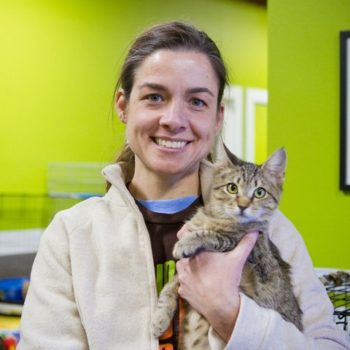Can inspiration turn into lasting change for animals? Absolutely! Here’s one shelter director’s journey from “Aha!” to “Oh Yeah!”, as presented in the Maddie’s Fund sessions at the 2016 HSUS Animal Care Expo.
We’ll begin with the “Aha!”, the moment when Austin veterinarian Dr. Ellen Jefferson had an awakening that inspired her to help lead her community to no-kill. In speaking with a friend, she learned that another veterinarian was saying she wasn’t sold on no-kill because she’d rather die than live in a cage. That statement hit her with a jolt, because her uncle was shot down over Vietnam and was missing for 20 years. Growing up, she was part of a POW/MIA families support network, and she remembered that most of the people who came back said their strongest feeling during their imprisonment was not despair, but hope:
The whole time that they were in prison they had hope that they would be able to come home and be part of their family again. The vast majority of them did not commit suicide when they were there. So that to me means that if a person actually was placed in that situation where they would be in a cage for a long period of time with an undetermined outcome that they wouldn’t choose to be dead. So I don’t believe what she said.
What’s more, she said, that’s thinking about the problem all wrong:
(I)t doesn’t make sense that we would go from the problem of being in a cage to the solution of being dead. There is a whole cascade of solutions between this problem and this solution that are just completely missed with that kind of thinking.
And that’s really my Aha! Moment, that I believe that there are millions of problems in animal welfare and we have millions of opportunities to solve them. And we have the power to solve them. We as people have the power to solve every single problem that is in front of us if we just dedicate time and energy and thought to it.
Dr. Jefferson’s community took the power of that Aha! Moment and turned into a systematic program to save the lives of Austin’s animals. Through her organization, Austin Pets Alive!, they began saving the pets on the city shelter’s euthanasia list, using a network of foster homes. As they saved those most at-risk animals, they inherited the old city shelter, and were able to expand their lifesaving to include tougher cases, including dogs who weren’t yet behaviorally ready for a foster home.
So they created behavior and marketing programs to get those dogs ready for adoption. They revamped their adoption policies. They allied with their community to drive big change, and sustain it. And they changed how they talked about the animals in their care, even among themselves, but especially to potential adopters:
I think it’s kind of human nature where you introduce the dog to a person, and you tell them everything wrong about that dog first, and all the reasons that this dog is in the shelter, and not focus on the positive. But if you take a step back… if you were really introducing a friend to a friend you wouldn’t say all those horrible things about the friend who’s standing right there.
Or if you were going on a dating site or your first date you don’t say the ten things that are the most wrong with you, because you’re never going to get another date. So we try to apply that same principle to the dogs. We are not trying to hide anything, and nobody ever walks out of our shelter with an animal without knowing everything about them, the good and the bad. But that’s not how you make the introduction. That’s not how you make the connection.
Today, Austin is saving 98 percent of its dogs and cats. Dr. Jefferson says that will be sustainable if they don’t rest on their successes but “every day, look for a problem to solve.” So unless your community is out of problems, you should be able to follow your own journey from inspiration to “getting it done” and sustaining it. Who knows, maybe you’ll have your own Aha! Moment watching Dr Jefferson’s presentation, below!

